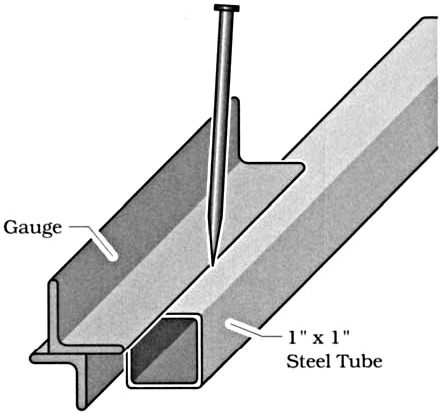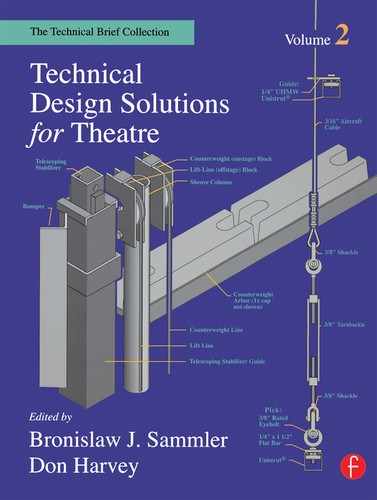Barbara J. Wohlsen |
A 4-Sided Steel-Marking Gauge |
A gauge design developed at the American Repertory Theatre offers an efficient method for measuring and marking standard steel shapes. The tool comprises two 6″ lengths of angle iron, one ¾″ x¾″ and the other 1″ × 1″, arranged in a pinwheel configuration. See Figure 1. These pieces overlap along their exterior faces by ½″. Spot welds on each end hold the gauge together. In its various orientations, this gauge provides measures of ¼″, ½″, ¾″, or 1¾. making it particularly useful for marking much of the tube steel, angle, and bar stock used in theatrical construction. This particular gauge is, of course, only a suggestion: different sizes of angle iron can be arranged to yield whatever measurements are required by a project. For quick and reliable measurement, one need only choose the appropriate side of the gauge and pass a scribe along its edge. See Figure 2.

FIGURE 1: GAUGE CONSTRUCTION

FIGURE 2: SCRIBING A CENTERLINE
Use of this gauge can noticeably speed construction, but the tool’s real benefit is its ability to establish regularity among pieces marked by several different people. For this reason, each shop’s set of gauges must be made in an identical fashion. At the American Repertory Theatre, the staff used a piece of ¼″ × 1″ bar stock to align the gauge’s pieces for the ¼″ measurement; the components were then clamped in place and welded together. The gauges were spray painted a bright color to prevent them from being thrown away, and each face was labeled so that the tool could be turned like an architect’s scale rule to find the proper side quickly. Although any gauge is only as accurate as the procedures used for its initial construction, using this tool as a steel shop’s measuring standard will ensure consistency among the many parts of a scenic element.
